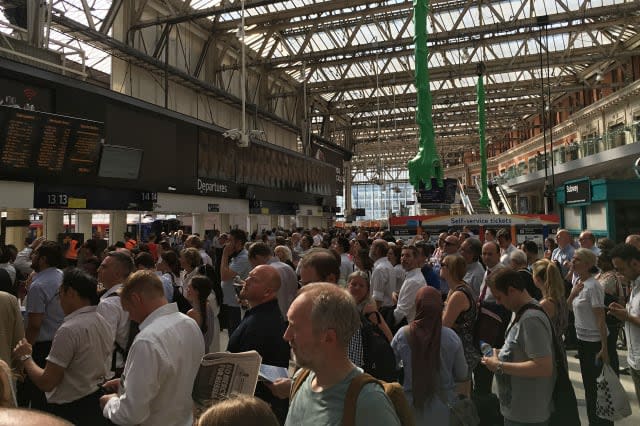Rail tracks melt as London stations descend into travel chaos

Hundreds of sweltering travellers struggled to navigate their way through London train service disruptions caused by lines damaged by the heatwave.
See also: Heatwave to give way to severe thunderstorms
See also: Southern Rail re-branded as 'Southern Fail' by commuters
Waterloo station was packed to the doors on Tuesday evening (pictured). High temperatures can cause rail tracks to buckle, so speed restrictions are sometimes enforced on tracks in adverse weather conditions.
And people ask why I don't want to live in London! #Waterloo tonight pic.twitter.com/dyNwu2doEo
— Skatronixxx (@Skatronixxx) July 19, 2016
It's too hot for the trains to run.
It's very unpleasant at Waterloo Station.
Don't come here unless you have to. pic.twitter.com/th0wsNcgjq— Kate Johnson KJ (@katesonofjohn) July 19, 2016
The scene at Waterloo station. @SW_Trains#heatwave#TrainDelaypic.twitter.com/3JXxoQuFGb
— Sweelin Ong (@sweelinong) July 19, 2016
Speed restrictions were imposed on a number of routes by Network Rail (NR) amid fears that tracks could buckle as temperatures exceeded 32C (90F). Great Western services to and from London Paddington were affected, with track temperatures reaching almost 50C (122F).

A number of Southeastern lines suffered from the temporary speed limits, including those between Lewisham and Blackheath, south-east London, Whitstable and Faversham, Kent and Hastings and Crowhurst, East Sussex.
Restrictions were also implemented on the route between Sheffield and Manchester Piccadilly. NR said rails can reach up to 20C higher than air conditions in direct sunlight on warm days.

They are made of steel and expand as they heat up and are subjected to strong compression. Speed restrictions are introduced in a bid to manage the expansion of the track by lowering the forces exerted on it.
If rails do buckle, lines must be closed and track repaired before services can resume. But this work cannot be carried out until the temperature has dropped, leading to severe disruption.
A spokesman for Network Rail said: "Our modern rails are far more resistant to heat expansion and buckling than they used to be.
"However, a day this hot affects even our track, so we need to restrict speeds for safety."



